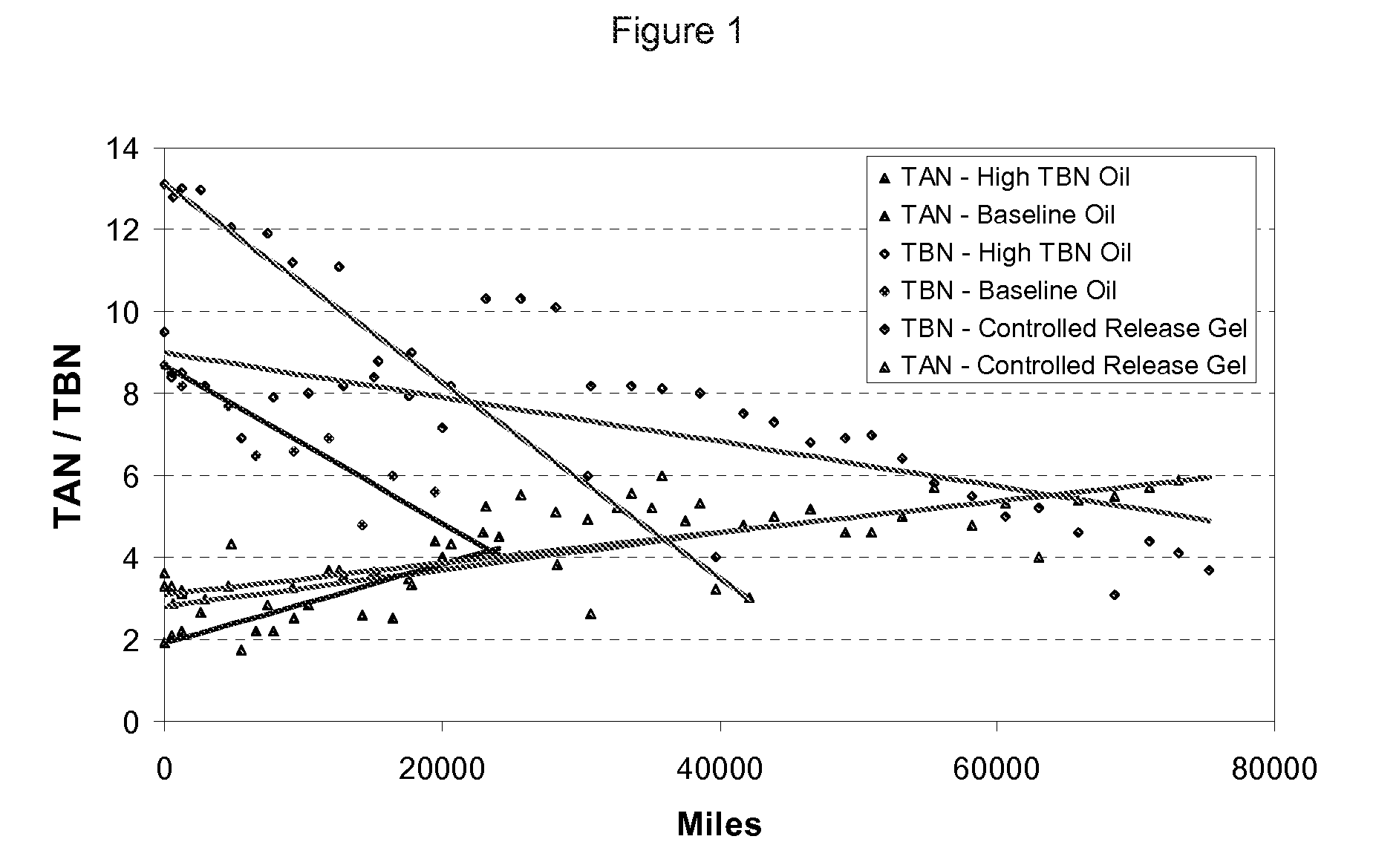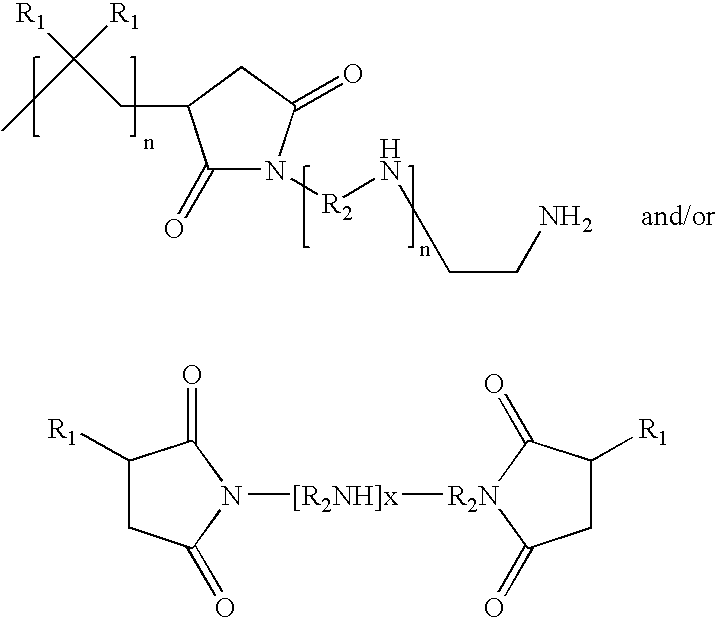Low Ash Controlled Release Gels
a technology of controlled release gel and ash, which is applied in the direction of liquid degasification, separation processes, group 5/15 element organic compounds, etc., can solve the problems of reducing the efficiency of the filter, affecting the life of the filter, and affecting the regeneration process, so as to reduce the level of ash produced, good physical characteristics of the gel, and good delivery of tbn
- Summary
- Abstract
- Description
- Claims
- Application Information
AI Technical Summary
Benefits of technology
Problems solved by technology
Method used
Image
Examples
specific embodiments
Examples 1-5
[0111]The gels of Examples 1-5 were made of the composition shown in the Tables 1-5 below by separately mixing components A and B, heating each component separately to about 100° C. and then combining A and B with mixing and subsequent curing at about 100° C. for about 10 hours to produce the gels listed in Table 1. The cone penetrometer is determined by ASTM D217.
TABLE 1Example 1Component% wtABA maleic anhydride / styrene copolymer10.0%10.0%partially esterified with C16 / 18 alcoholmixture to SRV 0.69, 40% mineral oilNonylated diphenylamine antiozidant30.0%30.0%Ashless dispersant made from 2000 Mn C12-5.0%5.0%assisted PIBSA and polyamine.Ashless dispersant made from 2000 Mn DA30.0%30.0%PIBSA and triethylene tetraamineA 400 TBN overbased Ca17.2%alkylbenzenensulfonate detergentA 105–106 Mn olefin copolymer in mineral oil,2.8%kin vis @ 100 C. (D445_100) = 1500 cStTrialkyl borate corrosion inhibitor5.0%2.5%2.5%Total100.0%47.5%52.5%Cone penetrometer =100 mm
TABLE 2Example 2Compon...
example 8
TBN Release Example
[0114]About 5 g of gel (formulation identified by example number) placed in about 50 g of Valvoline All Climate 10W-30 oil, and heated at about 100 C the sample was withdrawn at 1, 4, 7 and 11 days and tested for TBN using ASTM D4739 method. The results are shown in Table 8 below.
TABLE 8Percent of TBN ReleaseGel FormulationDay 0Day 1Day 4Day 7Day 11Example 10 9%51%69%87%Example 20 9%50%68%82%Example 3011%45%57%93%Example 6021%58%52%93%Example 7020%55%59%90%
example 9
Lower-than-theoretical Ash Release
[0115]A gel comprised of about (60% 400 TBN overbased Ca alkylbenzene sulfonate detergents about 20% ashless dispersant made from 2000 Mn PIBSA and about 20% nonylated diphenylamine antioxidant gel was loaded into diesel filters (320-420 g / filter), and installed onto a Series 60 Detroit Diesel Engine (two filters per truck) and run to about 30,000 to about 40,000 miles. Percent Ca (tested by ICP) and sulfated ash (tested by D874) present in the oil (Delo 400) was measured at the start, and the end of each of three tests.
[0116]Table 9 shows that the amount of sulfated ash (i.e. as CaSO4) actually measured (by ASTM D874) which is only about 75 to about 90% of that predicted based on the amount of Ca released.
TABLE 9CaAshExample 9 (320 g)Theory0.1701%0.51%Measured0.1100%0.28%DatesOct. 30, 2003 to Feb. 13, 20040.37%Predicted (by % Ca meas)% Ca Release 65% 75%% ash measured / predictedExample 9 (340 g)0.1807%0.54%Measured0.1140%0.35%DatesJun. 4, 2003 to...
PUM
| Property | Measurement | Unit |
|---|---|---|
| molar ratio | aaaaa | aaaaa |
| molar ratio | aaaaa | aaaaa |
| composition | aaaaa | aaaaa |
Abstract
Description
Claims
Application Information
 Login to View More
Login to View More - R&D
- Intellectual Property
- Life Sciences
- Materials
- Tech Scout
- Unparalleled Data Quality
- Higher Quality Content
- 60% Fewer Hallucinations
Browse by: Latest US Patents, China's latest patents, Technical Efficacy Thesaurus, Application Domain, Technology Topic, Popular Technical Reports.
© 2025 PatSnap. All rights reserved.Legal|Privacy policy|Modern Slavery Act Transparency Statement|Sitemap|About US| Contact US: help@patsnap.com



